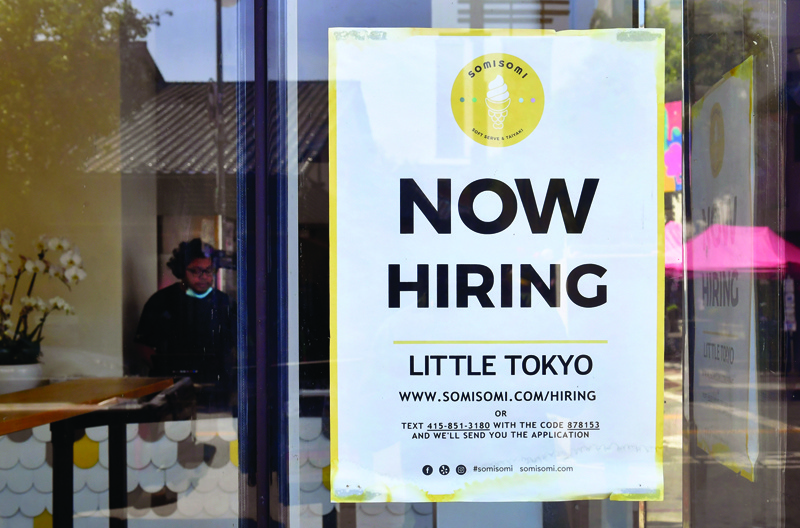 LOS ANGELES: In this file photo taken on May 28, 2021 a 'Now Hiring' sign is posted in front of an ice-cream shop in Los Angeles, California. - AFP
LOS ANGELES: In this file photo taken on May 28, 2021 a 'Now Hiring' sign is posted in front of an ice-cream shop in Los Angeles, California. - AFPWASHINGTON: President Joe Biden on Friday cheered the "historic" US rebound from the COVID-19 crisis as the economy gained 850,000 new jobs in June, cementing the evidence of a broad recovery. The uptick was better than expected and came after two months of disappointing results, buoyed by big increases in the hard-hit leisure and hospitality sector, the Labor Department said in its closely watched monthly report.
With the latest gains, the world's largest economy has added 3.3 million jobs in the first six months of the year. "This is historic progress, pulling our economy out of the worst crisis in 100 years," Biden said at the White House. The Democratic president credited the massive American Rescue Plan approved in March and the rapid acceleration of vaccinations as factors fueling the economic revival.
"Our economy is on the move and we have COVID-19 on the run," Biden said, though he acknowledged there is more work to do. The unemployment rate last month ticked up to 5.9 percent from 5.8 percent in May, the data showed, and the jobless rate for Black workers rose a tenth of a point to 9.2 percent. The data also showed the economy is still short 6.8 million jobs compared to February 2020.
Biden called for more "critical investments" in infrastructure outlined in his American Jobs Plan, including roads and bridges but also childcare and higher education. "It's going to help us create more good jobs, ease the burden on working families, and strengthen our economy-strengthen it in the long run," the president said.
Worker shortage boosting wages
As the United States has brought the pandemic under control, Americans have been able to attend professional sports games, travel, and dine out and celebrate weddings in person. The sector has hired at a rapid pace, adding 343,000 positions last month, the report said. However, it is still short 2.2 million jobs from the pre-pandemic level. Education gained 230,000 positions at the state and local government level, while manufacturing gained 15,000. But construction lost jobs, and more workers saw their hours increased.
"While today's report was shy of the coveted 1-million mark, it paints a picture of a steadily recovering jobs market," said Lydia Boussour of Oxford Economics. While she noted that many companies continue to report difficulties finding people to fill open positions, she said the strong performance "is likely the start of a series of stellar reports that will underpin the strongest US economic performance since 1951 this year."
The labor shortage also is driving wages higher, with average hourly earnings rising by 10 cents to $30.40 in June, following larger increases in May and April, the report said. Biden said that dynamic tips the balance of power in favor of workers and "gives them the power to demand to be treated with dignity and respect." "More jobs, better wages. That's a good combination," he said. Wall Street was ebullient about the "Goldilocks" report and seemed to have tamed investors' fear that rising wages will spark uncontrolled inflation, with all three major indices posting new records ahead of the July 4 holiday weekend.
Mixed data?
Still, the struggle to find workers as businesses reopen has become a political issue, with Republicans blaming the generous federal jobless benefits as keeping potential hires on the sidelines. As a result, 22 state governments have terminated supplemental unemployment benefits early, and another four states have announced plans to follow suit, although some face legal challenges. The extra benefits are set to expire in September.
Robert Frick of Navy Federal Credit Union downplayed the rising jobless rate and said there are signs of good news ahead. "The unemployment rate nudged up because more Americans are seeking jobs, and good employment gains for teachers will have a multiplier effect in the next few months, as that allows kids to go back to school and frees over a million parents to return to work," he said of the data.
Meanwhile, the broadest measure of joblessness fell below 10 percent for the first time since the start of the pandemic. That "U6" rate-which includes those who work part-time because they cannot find full-time work, as well as discouraged workers who are not looking for a job-peaked at just under 23 percent in April 2020.
Still, the figures showed some mixed results as the ranks of the long-term unemployed-those jobless for 27 weeks or more-rebounded after declining in May. And employment in the auto sector fell by more than 12,000, which economists say is linked to the global semiconductor shortage that has hindered production, as well as annual summer factory shutdowns. - AFP










